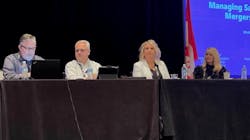SAN ANTONIO—Stakeholders from three prominent North American trucking companies joined here for a June 13 program to hash out the complex process of merging safety policies and processes when their fleets are evaluating acquisitions of other trucking companies or are carrying them out, and they boiled it all basically down to a simple message: Process is important, but put people first—both on the buying side and selling side, drivers and staff.
Panelists Garth Pitzel, associate VP of safety and driver development for Bison Transport; Lisa Gonnerman, president of refrigerated trucking for Bay & Bay Transportation; and Joey Ballard, executive VP of people and safety at Covenant Transport Services joined the moderator, Scott Achelpohl, managing editor of FleetOwner, in an hour-plus discussion, “Managing Safety Cultures Through Mergers and Acquisitions,” that served as the capstone session to the 2023 Truckload Carriers Association (TCA) Safety & Security Meeting here.
The three-day conference, attended by about 340 registrants (mainly safety stakeholders and C-suite personnel from over-the-road fleets) consisted of 17 main sessions and several "safety-in-the round" side sessions, but Pitzel, Gonnerman, and Ballard put a bow on it all with an at-times-lively talk covering six prepared questions followed by answers to questions from the audience.
See also: TransPro’s Frolick named Safety Professional of the Year
Bison, No. 63 on the FleetOwner 500: Top For-Hire Fleets of 2023, is one of Canada’s largest trucking companies and the 2022 Fleet Safety Grand Prize winner in the large-fleet category, a TCA and CarriersEdge Hall of Fame freight-hauler, and a Best Fleets to Drive For Hall of Famer. All spoke authoritatively about the safety implications of M&As, but more so about preparing people.
All spoke authoritatively about the safety and staff implications of M&As. All also have guided buyer (usually their own) and seller fleets through the process, which can take as little as weeks but as long as months. They used words like “build trust,” “exercise due diligence,” “talk and understand,” and “have a defined communication plan.”
“Emotions are always so high when we go through mergers and acquisitions,” said Ballard, who has been involved in five logistics M&As throughout her career and has been on both sides, the buying company and the selling entity, in the deals. Her advice: Meet those emotions, which arrive lots of times from drivers and staff at the fleet being acquired who are facing uncertain futures, head-on with a “defined, intentional, [and] continual communication plan.”
See also: Report shows improved driver safety despite increasingly hazardous roadways
“They will want to know what you’re going to engage in first,” added Ballard, who has been with Covenant for 25 years in oversight of safety, human resources, driver recruiting, marketing and communications, and orientation and onboarding.
Pitzel, who has been involved in seven acquisitions and one change in ownership group, preached honesty and plain-spokenness: “To say things aren’t gonna change is absolutely a lie. Change is inevitable. You need a couple of wins and credibility with people. Those wins could be something relatively minor.”
“You have to put yourself in those people’s shoes, be empathetic,” added Gonnerman, who said she’d been deeply involved in seven mergers and acquisitions in her career plus several private fleet conversions. Her most recent experience was with TFI International, which included four acquisitions in the last five years.
Do the two safety cultures fit?
Two session questions on June 13 dealt with the importance of evaluating, during the run-ups to deals, the two fleets’ cultures and whether their philosophies and safety practices are compatible and make for a future combined organization that will succeed in keeping accidents down and drivers safe.
Pitzel’s best advice on how to determine “fit”: Talk to key people in the company being acquired and have in-depth discussions on the contours of that fleet’s safety culture, or the lack thereof.
See also: CEOs stress building and keeping a solid safety culture
Gonnerman advised “due diligence” by examining a carrier’s safety numbers and programs. “Do they value that piece of it?” she asked. “At first chance, talk to safety people AND drivers.”
At another point in the program, she said a buyer should gauge how willing people at the carrier that is being acquired are to change. “Talk and understand how they do what they do and why they do it,” adding: “We have walked away from some acquisitions because there was so much risk.”
Ballard added that “what’s on paper”—in other words, the fleet’s written safety policies and procedures—“may not be what the safety department is executing. Identify the disconnects.”
What makes an M&A difficult? Top 3 from the three
All three panelists were asked for a Top 3 list of factors that made their past deals difficult. Their responses varied widely, yet fell along similar threads.
Ballard advised deals are made more arduous when people aren’t prioritized in an acquisition. And she stressed communication—authentic communication, especially to drivers, many of whom, she conceded, view themselves as the “boots on the ground,” on the front lines of a fleet’s safety success or failure. “Can you say what the future will look like?” she asked. “Can you say what’s next, what’s going to happen? If you are transparent and honest, they respect that, even if it’s not what they want to hear.”
Pitzel emphasized the acquiring company must be sure to battle the attitude by staff and drivers at the carrier being acquired that “you’re the big, bad company, coming to take over.” Along that theme, Gonnerman added: “Have people there they can contact. Have key drivers in there to talk about what they’ve been through. If you don’t have an answer, people will fill in the blanks with what is going to be not the right answer.”





